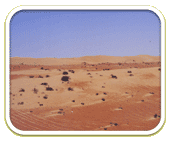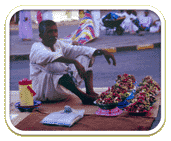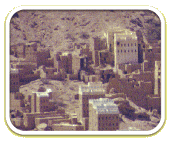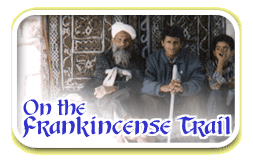 |
 |
 |
|
|||
|
On The Frankincense Trail Most drivers try to avoid ending up in the middle of nowhere. I, on the other hand was headed straight for it, a place called the Rub' al Khali, the world's largest sand desert . It's a terrifying expanse of nothingness the size of France, whose name means simply the Empty Quarter. 
You'll find it in the atlas straddling the border between Saudi Arabia and Oman - the undemarcated border, in the parlance of cartographers. It's a nebulous, dotted line in the sand that nobody really cares about, because nobody in his right mind goes near it . . . not even the Beduoin, the hardiest desert tribesmen around. My destination was the fabled lost city of Ubar, a major frankincense trading center that, according to the Koran, was swallowed up by the sands after its people turned their backs on God . . . a sort of cross between Atlantis and Sodom and Gomorrah. No question, there's a mighty big sinkhole out here, surrounded by the crumbling remains of a 5000 year-old settlement which some archaeologists claim is Ubar. Engineer Gopi Martin, whose been in charge of shoring up the site, doesn't believe the remains are expansive enough to be the lost city of legend, but he does recognize there was some kind of settlement here that experienced a huge natural catastrophy, thanks, in part, to the corrosive action of an underground spring on soft limestone.
Martin: "The limsetone get, you know, muddy-like, and you've got continuous flow of water, so the caves become bigger and bigger and bigger." 
While many of the great frankincense cities such as Ubar have been erased by desert sands, others along the trail continue to thrive, their economies still buoyed by local industry, including frankincense. Arabs use frankincense to scent their homes and their clothes. Even, sometimes, to settle an upset stomach, by swirling a few grains of it in their drinking water. In the spice market of Say'un in central Yemen, for instance, merchants tempt buyers with chants of bakhoor, frankincense for sale, only 300 rials. This is about two dollars a pound, a far cry from the days when it was worth more than its weight in gold. Those days, of course, are long gone, but 4th generation spice merchants like Hamed Mahadini can still recall when frankincense arrived here by camel.
Mahadini: "It always came here by caravan. We had no cars in those days, and so it had to come by camel, from the seaports and overland." 
Barreling down the dusty roadways of central Yemen - the very heart of the frankincense trade route - my driver drew my attention to the crumbling remains of various, fortress-like custom houses along the way, strategically perched on hilltops so that no caravan could sneak by without paying the requisite duty.
Verde: "So they would make the caravans stop there." Some of these fees ran as high as 30 percent , which is one of the reasons why frankincense was so expensive by the time it got to the Mediterranean. The central authority behind this usurious and highly profitable system of taxation was the kingdom of Saba, or Sheba as its called in the Old Testament. Sheba's most famous monarch was the queen who traveled to Solomon's court to test his wisdom, and thereby that of his Hebrew God. But considering that the Queen of Sheba controlled the flow of frankincense north to Jerusalem, it's likely Solomon was just as eager to meet with the her.
Vogt: "There was an economic interest in meeting." Archaeologist Burkhard Vogt is director of the German Archaeological Institute in the Yemeni capital of Sana'a. 
Vogt: "People of course depended on the supplies of frankincense for their rituals, for their cults in Egypt, in Israel, in Syria and even in Mesopatamia, so they were very much interested in a regular and safe supply of frankincense." So rich and lush, says Vogt, was the Queen's capital city of Marib . . . a few hours east of Sana'a . . . that visitors could wander there for months and never once see the sky through the dense canopy of date palms. Today, Marib is a trash-strewn collection of decaying mudbrick buildings, but all roads once led to and from here, thence on into modern-day Saudi Arabia, my next stop. So join me Tom Verde, as I continue to explore the frankincense trail for the Savvy Traveler. Air transportation and accommodations provided by the Oman Ministry of Information
{ On the Frankincense Trail: Part One | Part Two | Part Three | Part Four | Part Five }
|
 | American Public Media Home | Search | How to Listen ©2004 American Public Media | Terms of Use | Privacy Policy |
